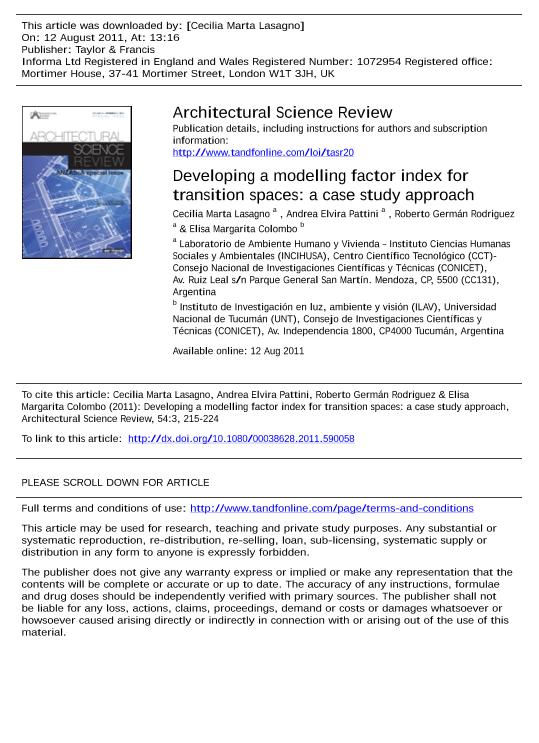Mostrar el registro sencillo del ítem
dc.contributor.author
Lasagno, Cecilia Marta

dc.contributor.author
Pattini, Andrea Elvira

dc.contributor.author
Rodriguez, Roberto Germán

dc.contributor.author
Colombo, Elisa Margarita

dc.date.available
2020-01-16T15:00:56Z
dc.date.issued
2011-08-12
dc.identifier.citation
Lasagno, Cecilia Marta; Pattini, Andrea Elvira; Rodriguez, Roberto Germán; Colombo, Elisa Margarita; Developing a modelling factor index for transition spaces: A case study approach; Taylor & Francis; Architectural Science Review; 54; 3; 12-8-2011; 215-224
dc.identifier.issn
0003-8628
dc.identifier.uri
http://hdl.handle.net/11336/94874
dc.description.abstract
Transitional spaces (TS) are characterized by possession of high gradients of luminances between inside and out, which places a great demand on the users' visual system's function. A satisfactory descriptive indicator of this kind of situation could be a 'modelling factor' (MF), defined from cylindrical illuminance and horizontal illuminance measures. It would provide information on the depth and dimensionality of objects present in the scene, also taking into account a region's overabundance of daylight. A public building was selected as a case study, and solar light behaviour, including its interaction with the space, was monitored. Measurements were taken during an entire year at the start of each season (2008) under clear skies, at the beginning and at the end of each working day. Another measurement was taken in winter (2009) under overcast skies at 13:00, so as to obtain a comparative parameter. It was found that unfavourable conditions were produced in all seasons for about 2 hours, except at 09:15 in winter. All the data collected in the control situation were within the optimum modelling range, with values ranging between 0.3 and 0.4. The MF allows the integration of most relevant factors intervening in TS and emerges as a good descriptor for TS.
dc.format
application/pdf
dc.language.iso
eng
dc.publisher
Taylor & Francis

dc.rights
info:eu-repo/semantics/openAccess
dc.rights.uri
https://creativecommons.org/licenses/by-nc-sa/2.5/ar/
dc.subject
DAYLIGHT IMPACT
dc.subject
LIGHT MODELING
dc.subject
TRANSITIONAL SPACE
dc.subject
VISUAL ADAPTATION
dc.subject.classification
Ingeniería Arquitectónica

dc.subject.classification
Ingeniería Civil

dc.subject.classification
INGENIERÍAS Y TECNOLOGÍAS

dc.title
Developing a modelling factor index for transition spaces: A case study approach
dc.type
info:eu-repo/semantics/article
dc.type
info:ar-repo/semantics/artículo
dc.type
info:eu-repo/semantics/publishedVersion
dc.date.updated
2019-12-04T15:09:26Z
dc.journal.volume
54
dc.journal.number
3
dc.journal.pagination
215-224
dc.journal.pais
Reino Unido

dc.journal.ciudad
Londres
dc.description.fil
Fil: Lasagno, Cecilia Marta. Consejo Nacional de Investigaciones Científicas y Técnicas. Centro Científico Tecnológico Conicet - Mendoza. Instituto de Ciencias Humanas, Sociales y Ambientales; Argentina
dc.description.fil
Fil: Pattini, Andrea Elvira. Consejo Nacional de Investigaciones Científicas y Técnicas. Centro Científico Tecnológico Conicet - Mendoza. Instituto de Ciencias Humanas, Sociales y Ambientales; Argentina
dc.description.fil
Fil: Rodriguez, Roberto Germán. Consejo Nacional de Investigaciones Científicas y Técnicas. Centro Científico Tecnológico Conicet - Mendoza. Instituto de Ciencias Humanas, Sociales y Ambientales; Argentina
dc.description.fil
Fil: Colombo, Elisa Margarita. Consejo Nacional de Investigaciones Científicas y Técnicas; Argentina. Universidad Nacional de Tucumán. Facultad de Ciencias Exactas y Tecnología. Departamento de Luminotecnia, Luz y Visión; Argentina
dc.journal.title
Architectural Science Review
dc.relation.alternativeid
info:eu-repo/semantics/altIdentifier/url/http://www.tandfonline.com/doi/full/10.1080/00038628.2011.590058
dc.relation.alternativeid
info:eu-repo/semantics/altIdentifier/doi/https://doi.org/10.1080/00038628.2011.590058
Archivos asociados
